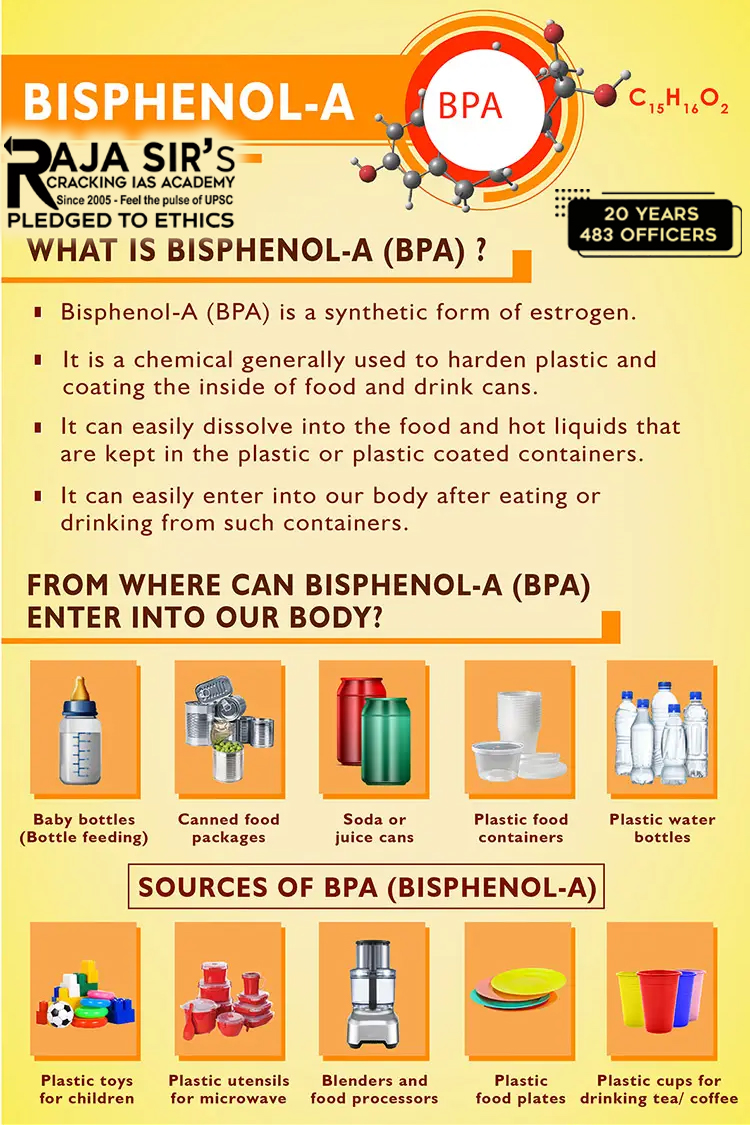- Home
- Prelims
- Mains
- Current Affairs
- Study Materials
- Test Series
Bisphenol A: What is it?
Bisphenol A (BPA) was first synthesized in 1891. It is used to make clear, strong, and lightweight plastics known as polycarbonates. These polycarbonate plastics are very common – they are used in reusable water bottles, baby bottles, plates, cups, and containers for storing food. BPA is also used for creating epoxy resins that are used to line the inside of food and drink cans. Other than food packaging and containers, BPA is used for manufacturing electronics, construction materials, and medical devices among other things.
BPA is primarily used in manufacturing:
- Polycarbonate plastics: Found in water bottles, baby bottles, food containers, eyewear, and electronics
- Epoxy resins: Used to coat the inside of metal food and drink cans, bottle tops, and water supply pipes
- Other products: CDs/DVDs, sports equipment, automotive parts, and medical devices

Routes
We come into contact with bisphenol-A through various routes. Firstly, BPA can migrate from containers and materials that come into contact with food such as plastic bottles and the lining of food cans. When these containers are heated, reused excessively, or exposed to acidic or basic substances, BPA transfer to food increases. Acidic substances in food typically include citrus fruits, tomatoes, and vinegar-based products, which have a low pH and can contribute to breaking down the chemical bonds in plastics, allowing the release of BPA. On the other hand, basic (or alkaline) substances in food might include baking soda or certain dairy products, which have a higher pH and can also affect the integrity of plastic containers. BPA migration is especially a cause for concern in high-fat foods and when the packaging directly touches the food for a long time or is exposed to higher temperatures.
Secondly, BPA is considered an omnipresent environmental contaminant, found in air, soil, and water due to its widespread use. Environmental exposure to BPA results from contamination of the atmosphere, aquatic environments, and soil, largely due to industrial use and recycling processes. BPA can last in the environment for a while, but microorganisms present in water bodies as well as sunlight help decompose it over time. Occupational exposure to BPA occurs primarily among workers involved in its production.
Harmful Effects
BPA is known to pose several health risks:
- Hormonal disruption: Mimics estrogen and interferes with endocrine function
- Reproductive issues: Linked to reduced fertility and developmental problems in foetuses and infants
- Immune system impact: May impair immune responses and increase risk of autoimmune diseases
- Cancer risk: Associated with increased risk of breast, ovarian, prostate, and testicular cancers
- Other effects: Eye damage, skin allergies, airway irritation, and metabolic disturbances
Exposure & Safety
- Main exposure route: Through diet, especially canned foods and plastic containers
- Leaching risk: BPA can leach into food and drinks, especially when containers are heated
- Regulations: Many countries have restricted BPA use in baby products and food packaging.
BPA is considered hazardous due to its potential to affect the immune system, harm fertility, disrupt hormones, and increase the risk of various cancers, among other health concerns. Regulatory measures have been implemented to limit BPA exposure, including specific migration limits and bans on its use in certain products for infants and young children.

UPSC CIVIL SERVICES EXAM - PREVIOUS YEAR QUESTIONS
1. Bisphenol A (BPA), a cause of concern, is a structural/key component in the manufacture of which of the following kinds of plastics? (2021 PRELIMS)
(a) Low-density polyethylene
(b) Polycarbonate
(c) Polyethylene terephthalate
(d) Polyvinyl Chloride
Answer: (b)
2, What is Bisphenol A (BPA)? (2008 PRELIMS)
(a) A medical test for detecting cancer
(b) A test for testing the use of drugs to improve performance by athletes
(c) A chemical used for the development of food packaging materials
(d) A special type of alloy steel
Answer: (c)
3. With reference to polyethylene terephthalate, the use of which is so widespread in our daily lives, consider the following statements:
- Its fibres can be blended with wool and cotton fibres to reinforce their properties.
- Containers made of it can be used to store any alcoholic beverage.
- Bottles made of it can be recycled into other products.
- Articles made of it can be easily disposed of by incineration without causing greenhouse gas emissions.
Which of the statements given above are correct?. (2022 PRELIMS)
(a) 1 and 3
(b) 2 and 4
(c) 1 and 4
(d) 2 and 3
Answer: (a)
Explanation:
Polyethylene terephthalate (PET or PETE) is a strong, stiff synthetic fibre and resin and a member of the polyester family of polymers. PET is spun into fibres for permanent-press fabrics and blow-molded into disposable beverage bottles.
Statement 1 is correct: PET fibres make them highly resistant to deformation, so they impart excellent resistance to wrinkling in fabrics. They are often used in durable-press blends with other fibres such as rayon, wool, and cotton, reinforcing the inherent properties of those fibres while contributing to the ability of the fabric to recover from wrinkling.
Statement 2 is incorrect: Maharashtra government has announced the ban on sale of alcohol in PET bottles from April 1. Plastic packaging is dangerous to human health and the country liquor and country made foreign liquor cannot be sold in such bottles. PET has become widely used in carbonated-beverage bottles and in jars for food processed at low temperatures. The low softening temperature of PET—approximately 70 °C (160 °F)—prevents it from being used as a container for hot foods.
Statement 3 is correct: Polyethylene terephthalate is the most widely recycled plastic. For instance, PET bottles and containers are commonly melted down and spun into fibres for fibrefill or carpets.
Statement 4 is incorrect: Polyethylene, like other plastics, is not inert and is known to release additives and other degradation products into the environment throughout its lifetime. For example, the additive bisphenol-A used in the manufacture of many plastic products is leached as plastics age, and hydrocarbon gases are produced during high-temperature decomposition (>202°C).









 Latest News
Latest News
 General Studies
General Studies